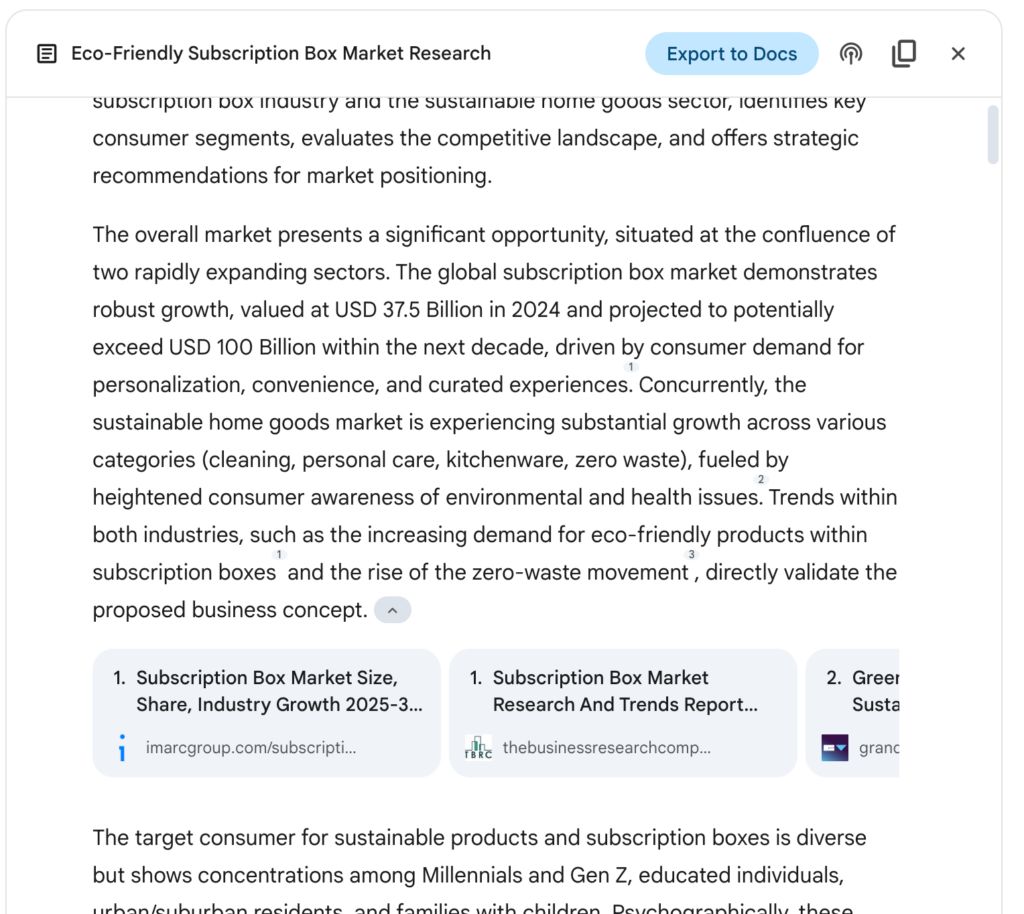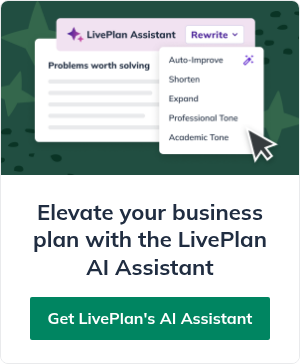How to do Market Research with AI in 2025

Jump to
Define Target Market SegmentsGet market size information for each segmentIdentify CompetitionResearching market trends and growthUsing “Deep Research” to turbocharge your market research projectAdditional ways to use AI for market research[Major Update: Since I initially explored this topic, the AI models have changed significantly. We have new tools, like “deep research” and the ability for chatbots to reliably browse the web and retrieve information. Because of all the changes, I’ve rewritten this piece completely to reflect how things are in 2025. For this piece, I used Gemini Advanced 2.5 Pro (experimental) and ChatGPT 4.5]
As I’ve explored how AI can help with business planning, I’ve wondered how useful tools like ChatGPT can be for market research.
While AI can help with writing parts of a business plan, I’ve been skeptical about how helpful it would be for market research.
That’s because market research typically involves gathering data – both from data sources with information about market sizes, and directly from potential customers to determine specific wants and needs.
This kind of factual data gathering has historically not been a strong point for AI. Tools like ChatGPT, Claude, and Gemini tend to “hallucinate” and make up information as they compose their answers.
When I first tried to use chatbots for market research, they just invented “facts” and confidently presented them to me as real information.
To state the obvious, you’d never want fictional market data in your business plan. You wouldn’t want to misrepresent your business opportunity to investors, and you certainly can’t afford to build a business based on inaccurate data.
But, things have changed. The chatbots of 2025 are smarter, better at gathering information, and more useful.
In this post, I’ll walk through how to use AI to help you do market research. I’ll be doing market research for a subscription box business for eco-conscious home goods that delivers a curated selection of sustainable, plastic-free, or zero-waste products for the home (e.g., cleaning supplies, personal care items, kitchen gadgets).
Here are the main market research tasks that I’ll be digging into:
- Identifying target market segments
- Determining the size of each market segment
- Identifying competitors and doing competitive research
- Researching market trends and growth
- Creating a survey to gather information from prospective customers
- Developing target market personas
- Generating marketing campaign ideas
Let’s get started, and see how AI does with these core market research tasks.
Related Reading: 8 Best AI-Powered Business Plan Generators Ranked
Define Target Market Segments
A first step for any market research project is to define the target markets that your ideal customers fall into. As a quick refresher, a target market is a group of potential customers that you plan to sell to.
Each different target market that a company sells to is a “segment.”
Target markets are often defined by either demographics or psychographics, or a combination of the two. Demographics are things such as age, location, gender, and income. Psychographics are interests, hobbies, and habits.
For our subscription box business, the first step is to brainstorm different potential target markets and define the core demographics and psychographics for each segment.
Using the following prompt generated a list of potential market segments, with their demographics and psychographics defined.
Here is ChatGPT’s response:

Here is Gemini’s response to the same prompt:

Verdict: AI delivers some good ideas for target markets with details about each market segment. If I were starting this business, I’d use these ideas as a starting point and see if I could talk to potential customers in each segment to gauge interest in my subscription box business. That might help me narrow things down so I only focus on one or two market segments initially before expanding to try and reach other parts of the market.
AI is a very useful tool for this stage of market research. It helps brainstorm market segments and come up with some new ideas. It also helps start the process of thinking about how I might position my business for each target market.
Different AI tools do come up with different results and ideas. If you have access to multiple tools, it can be helpful to run the same query in different AI tools and then cherry-pick the results that you find useful from each one.
Get market size information for each segment
The next step is to understand how big each market segment is. I need this information so I can get a better understanding of how many potential customers I might have.
I’ll use this information to help determine if I might be able to build a sustainable business. If the market is too small, it might not be worth pursuing this business.
I don’t need to determine the sizes of every market segment that AI suggested and I might have thought of additional market segments that I didn’t surface. Either way, this is where human editing and judgement come to play. I need to decide which market segments seem realistic for my business and combine this with my own knowledge and intuition about my potential customers.
When I have the short list of segments I’m interested in, I’ll use AI to help determine market sizes.
ChatGPT:

Gemini:

Verdict: AI chatbots have come a long way and can be reliable research companions. Unlike the chatbots of 2024 and earlier, the level of hallucination is greatly reduced. ChatGPT provided linked sources for all of the information it surfaced and I found it accurate and useful. Not only that, but it helped find valuable sources of information that I might not have found if I had just been running Google searches. Gemini provided what looked like valid research information, but it didn’t cite its sources, making it difficult to rely on for this task. (I’ll talk about a work-around for this later in this article)
Identify Competition
Part of understanding your potential customer includes getting an understanding of what other products or services they may be using – this is your competition. No business plan is complete without a solid understanding of your competitive landscape.
ChatGPT:

Gemini:

Verdict: Both Gemini and ChatGPT provided interesting lists of potential competitors, both direct and indirect. ChatGPT was more immediately useful with direct links to the competitors so I could verify them. It’s a good thing, because some of the competitors had gone out of business and ChatGPT did not know this. Gemini was useful and surfaced a similar list, but added in a list of local competitors as well as a more comprehensive list of alternate providers/competitors. But, none of the competitors were linked, so I would have to cut and paste each into Google to verify all of the information.
Overall, AI was helpful at providing a jumping-off point for competitive research and got the work started, but it needed some manual labor to complete the competitive analysis – verifying the competitors, removing some that weren’t truly competitors, and validating price points and other factors.
Keep in mind that I am using a single conversation thread with each of the chatbots so that they should have context of the prompts that I’ve provided as well as the responses that they have provided. This makes prompting easy and the AI knowledge builds up as we continue to do research.
Researching market trends and growth
The purpose of market research is twofold. First, you want to understand your customer so that you can build a successful business. Second, you can use your market research to customize your business offering, helping you stand out from the competition and offer something unique in the market.
In general, I’ve found that AI chatbots are most helpful with these types of creative tasks. They can help generate ideas and spur creativity.
ChatGPT:

Gemini:

Verdict: From a research perspective, ChatGPT provided linked sources to the market size data that it surfaced. The sources seemed reputable and useful. Gemini mentioned sources, but did not link anything, making me hesitant to recommend trusting the data without doing a lot of double-checking.
However, on the positioning portion of the exercise, both chatbots excelled at providing insightful ideas. It’s these types of creative jobs that AI chatbots tend to excel at – you can count on them to be useful brainstorming partners. You may not use all of their ideas, but they get you thinking about how you might approach a particular problem.
Using “Deep Research” to turbocharge your market research project
“Deep Research” is a feature of Gemini and ChatGPT on their paid plans. In deep research mode, both chatbots will take your query, develop a research plan, search the web, and return a detailed research report. The queries usually take 5-20 minutes to complete, and the results can be impressive. If you have access to these tools, it’s worth using them for market research tasks. I’ve found them to be more detailed and accurate than just using the standard chat interface.
For a market research task using deep research, you essentially combine your entire project into a single, large prompt and set the AI loose on the task. ChatGPT typically will ask follow up questions before starting the research. Gemini will present the research plan and allow you to modify the plan before it starts.
ChatGPT:

Gemini:

The deep research output of both Gemini and ChatGPT is impressive and useful. The reports can be a foundation for further research of your own and data gathering. And, using the chatbots, you can query the reports to answer additional questions. If you want to know more, read an in-depth review of the deep research tools from Gemini and ChatGPT. Like any other research done with AI, it’s crucial to validate all data and assumptions before copying the information into your business plan. They aren’t always accurate and the AI does still make mistakes. But, overall, the accuracy rate is pretty high and the reports are a fantastic jumping off point.
You can look at the reports that I ran here: Gemini | ChatGPT
Additional ways to use AI for market research
AI chatbots are a mixed bag for market research. They’re useful for creative tasks and brainstorming, but are less Beyond market research, AI can be extremely helpful at generating ideas and helping with additional marketing tasks. Here are a few other examples that AI can be helpful with as you work on your market research project:
- Understand your industry and identify potential opportunities and challenges. AI can help you get an understanding of how your industry works and help you develop strategies to thrive. This is useful to better understand the business that you’re in and trends that may be developing within your industry.
- Create a survey. Market research isn’t complete without actually talking to your potential customers. You can use AI to get a jump start on a survey that you can send out to potential or existing customers to better understand their needs, current purchase habits, and other information that may be useful for your business.
- Develop personas. A buyer persona is a description of a potential customer. It helps you transform market research data into a useful profile of someone who might purchase your product or service, informing your marketing and product or service design.
- Generate marketing campaign ideas. As your market research helps you define who your target market is and what their needs are, you can leverage that information to generate campaign ideas to reach your audience through advertising and other methods. AI can help generate ideas and even come up with initial marketing copy for your ads.
While you can’t just cut and paste AI market research into your business plan, the tools available in Spring of 2025 are useful and impressive. Especially if you have access to deep research on either of the platforms, you can jump-start your market research.
And, of course, entrepreneurs are still a necessary part of the equation – questioning data and sorting through ideas to determine which are worth investing time and money in.













